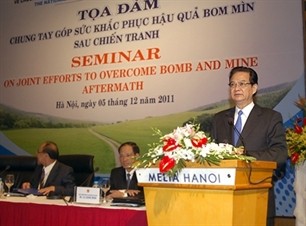Nearly 40 years after the war, Vietnam is still suffering from wartime aftermaths with the number of landmine victims mounting year after year. A Steering Board for the National Action Programme on resolving consequences of unexploded ordnances (Steering Board 504) for the 2010-2025 period was created last week in Hanoi. The Steering Board will help mobilize domestic and international resources and create uniform mechanism to remove unexploded ordnances left from war.
The US army deployed more than 15 million tons of munitions during the war in Vietnam and about 800 thousand tons of remnants lie scattered over more than 6.6 million ha of land. Since the war ended in 1975, more than 42,000 people have died and 63,000 have been injured by post-war bombs and mines. The Vietnamese government has paid special attention to cleaning up the environment and allocated hundreds of millions of USD annually for the mission. However, accidents occur almost everyday, killing or injuring innocent civilians, who are often children. Prime Minister Nguyen Tan Dung, the head of the Steering Board 504, underlines the future task: “The Vietnamese government has approved a National Action Programme on resolving the consequences of unexploded ordnance left from the war. The government will make full use of domestic resources elicit support and cooperation from the international community to help Vietnam deal with landmines”.
 |
| Prime Minister Nguyen Tan Dung addresses a seminar in Hanoi |
Steering Board 504 aims to make Vietnam free from landmines, create a safe environment for socio-economic development and integrate landmine victims into their local community. Pham Quang Xuan, Commander of Corps of Engineers, said priority is given to the hardest hit areas: “From now to 2015, the program will survey and draw maps of landmine contaminated areas nationwide, work out a set of national technical standards and establish a center for management of UXO data. Landmine removal will be carried in Nghe An, Ha Tinh, Quang Binh, Quang Tri, Thua Thien Hue, Quang Nam and Quang Ngai provinces. Efforts should be made to clean up about 500 thousand ha of land in the next 5 years”.
The program also aims to educate people about the threat of unexploded ordnance to minimize accidents.
The National Action Programme on resolving consequences of unexploded ordnance is being coordinated with socio-economic programs. Responding to Vietnam’s call for assistance, several foreign governments and organizations have agreed to cooperate with Vietnam in addressing the issue. American Ambassador to Vietnam David Sheer expressed his country’s willingness to help Vietnam cope with the war consequences: Explosive remnants of war remain a complicated and challenging problem in Vietnam. I’m optimistic that together we mitigate the negative effects of UXO contamination. The United States looks forwards to continuing our work with the Vietnamese government, NGOs and other international partners to tackle this very important issue”.
The creation of Steering Board 504 marks a step forward in realizing the ultimate goal of eradicating landmines in Vietnam completely.
Vinh Phong